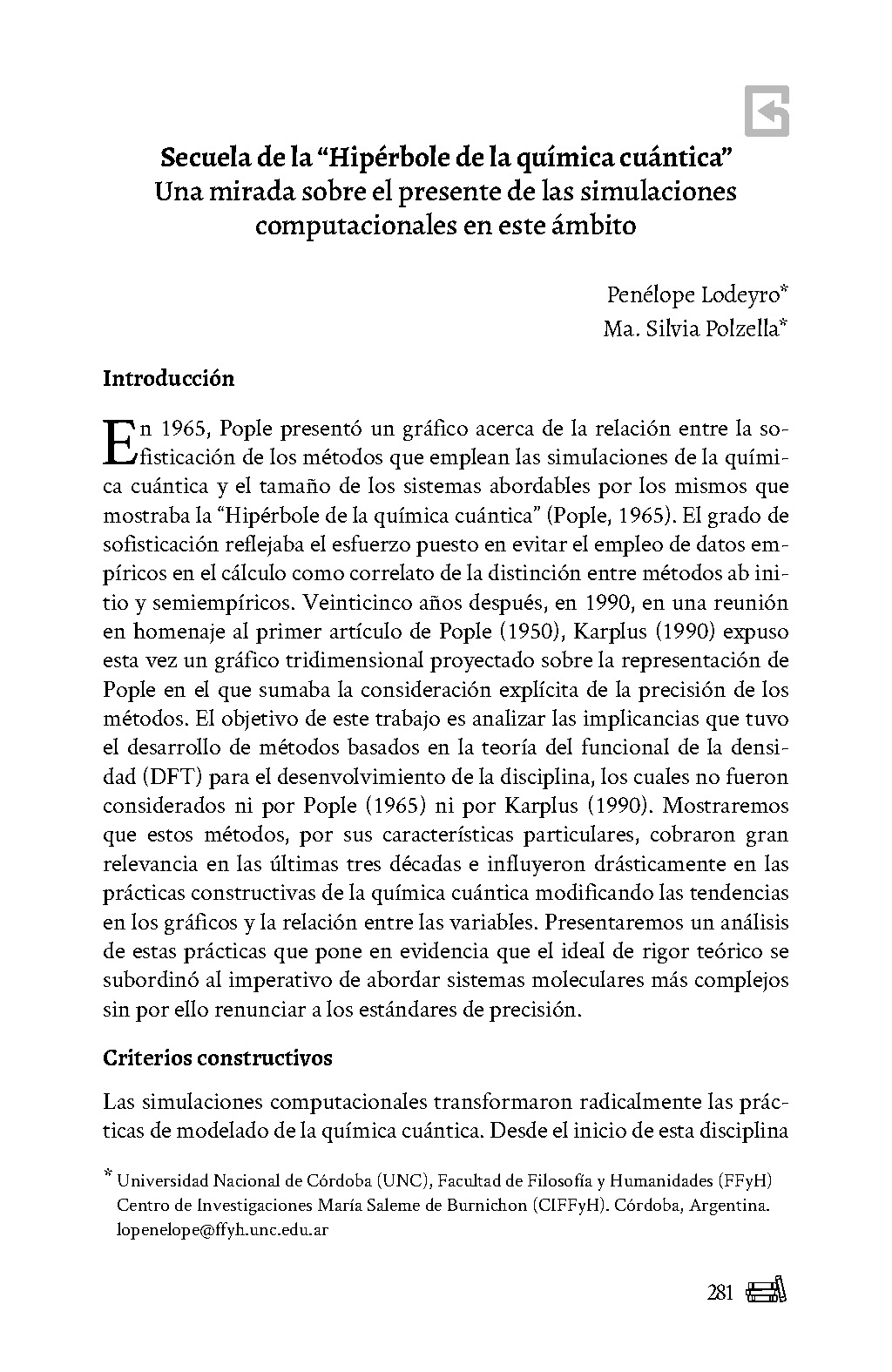Secuela de la “Hipérbole de la química cuántica” Una mirada sobre el presente de las simulaciones computacionales en este ámbito
Contenido principal del artículo
Resumen
Las simulaciones computacionales transformaron radicalmente las prácticas de modelado de la química cuántica. Si bien estas hacen un uso intensivo de métodos aproximativos, el alcance y el estatus epistemológico de los mismos, son cuestiones polémicas aún no resueltas. En 1965 una evaluación en términos de la relación entre la sofisticación de los métodos y el tamaño de los sistemas que pueden abordar, puso de relieve la llamada “Hipérbole de la química cuántica”. En este trabajo analizamos, desde la perspectiva actual, la deriva de la hipérbole tomando en consideración los métodos basados en la Teoría del Funcional de la Densidad (DFT), que en las tres últimas décadas transformaron las prácticas de las simulaciones computacionales de la química cuántica.
Detalles del artículo
Sección

Esta obra está bajo una licencia internacional Creative Commons Atribución-NoComercial-SinDerivadas 4.0.
- Los autores/as conservarán sus derechos de autor y garantizarán a la revista el derecho de primera publicación de su obra, el cual estará simultáneamente sujeto a la Licencia de reconocimiento de Creative Commons que permite a terceros compartir la obra, siempre que se indique su autor y su primera publicación en esta revista.
- Los autores/as podrán adoptar otros acuerdos de licencia no exclusiva de distribución de la versión de la obra publicada (p. ej.: depositarla en un archivo digital institucional o publicarla en un volumen monográfico), siempre que se indique la publicación inicial en esta revista.
- Se permite y recomienda a los autores/as difundir su obra a través de Internet (p. ej.: en archivos digitales institucionales o en su página web) antes y durante el proceso de envío.
Cómo citar
Referencias
Becke, A. D. (1988). Density-functional exchange-energy approximation with correct asymptotic Behavior. Physical Review A, 38(6), 3098- 3100.
Becke, A. D. (1993a). A new mixing of Hartree-Fock and local density-functional theories. The Journal of Chemical Physics, 98(2), 1372-1377.
Becke, A. D. (1993b). Density-functional thermochemistry. III. The role of exact Exchange. The Journal of Chemical Physics, 98(7), 5648- 5652.
Becke, A. D. (1996). Density-functional thermochemistry. IV. A new dynamical correlation functional and implications for exact-exchange mixing. The Journal of Chemical Physics, 104(3), 1040-1046.
Cohen, A. J., Mori-Sánchez, P., & Yang, W. (2012). Challenges for density functional theory. Chemical Reviews, 112, 289-320.
Dewar, M. J. (1992). A Semiempirical Life. Washington DC: American Chemical Society.
Fermi, E. (1927). Un metodo statistico per la determinazione di alcune prioprietà dell’atomo. Rendiconte della Reale Accademia Nazionale dei Lincei, 6, 602-607.
Freed, K. F. (1995). Building a bridge between ab Initio and semiempirical theories of molecular electronic structure. En J. L. Calais & E. S. Kryachko (Eds.), Structure and dynamics of atoms and molecules: Conceptual trends (pp. 25–67). Dordrecht: Springer Netherlands.
Gill, P. M. (2001). Obituary: Density functional theory (1927-1993). Australian Journal of Chemistry, 54(11), 661-662.
Goerigk, L., & Mehta, N. (2019). A trip for the density functional theory zoo: warnings and recommendations for the user. Australian Journal of Chemistry, 72(8), 563-573.
Grimme, S., & Schreiner, P. R. (2018). Computational chemistry: The fate of current methods and future challenges. Angewandte Chemie Int. Ed. 57, 4170-4176.
Hohemberg, P., & Kohn, W. (1964). Inhomogeneous electron gas. Physical Review, 136(3B), 864-871.
Karplus, M. (1990). Three-dimensional “Pople diagram”. The Journal of Physical Chemistry, 94(14), 5435-5436.
Kohn, W., Becke, A. D., & Parr, R. G. (1996). Density functional theory of electronic structure. The Journal of Physical Chemistry; 100, 12974-12980.
Kohn, W. & Sham, L. J. (1965). Self-consistent equations including exchange and correlation effects. Physical Review; 140(4A), 1133- 1138.
Norton Wise, M. (Ed.). (1995). The values of precision. Princeton, USA: Princeton University Press.
Pople, J. A. (1950). The molecular orbital theory of chemical valency. V. The structure of water and similar molecules. Proceedings of the Royal Society of London, 202, 323-335.
Pople, J. A. (1965). Two dimensional chart of quantum chemistry. The Journal of Chemical Physics, 43(10), 229-230.
Segall, M. D., Lindan, P. J. D., Probert, M. J., Pickard, C. J., Hasnip, P. J., Clark, S. J., & Payne, M. C. (2002). First-principles simulation: ideas, illustrations and the CASTEP code. Journal of Physics: Condensed Matter, 14, 2717-2744.
Thiel, W. (2005). Semiempirical quantum-chemical methods in computational chemistry. En Frenking, G., Kim, K. S. & Scuseria, G. E (Eds.) Theory and applications of computational chemistry (pp. 559- 580). Amsterdam: Elsevier.
Ramsey, J. (2000). Of parameters and principles: Producing theory in twentieth century physics and chemistry. Studies in History and Philosophy of Science, Part B; 31(4), 549-567.
Ramsey, J. L. (1997). Between the fundamental and the phenomenological: The challenge of “semi-empirical” methods. Philosophy ofScience, 64(4), 627-653.
Scerri, E. (2004). Principles and parameters in physics and chemistry. Philosophy of Science, 71(5), 1082-1094.
Thomas, L. H. (1927). The calculation of atomic fields. Mathematical Proceedings of the Cambridge Philosophical Society, 23(5), 542-548

